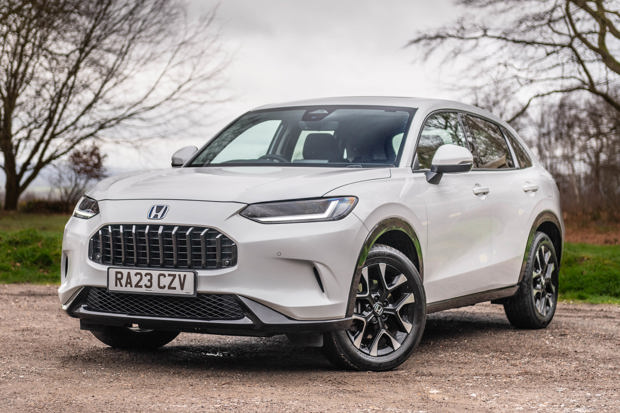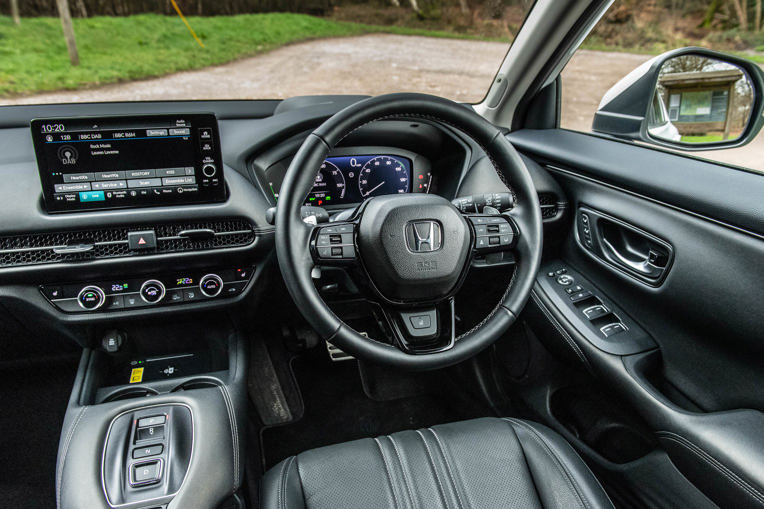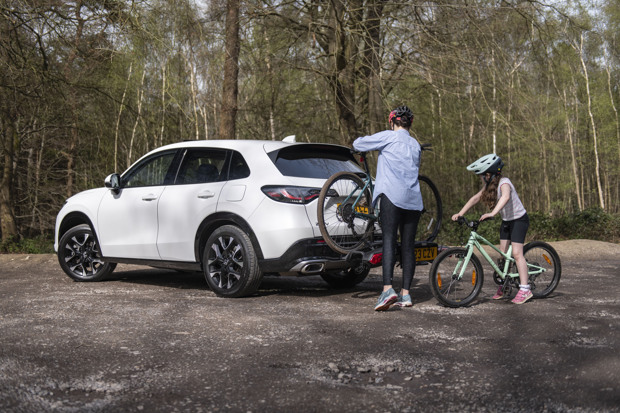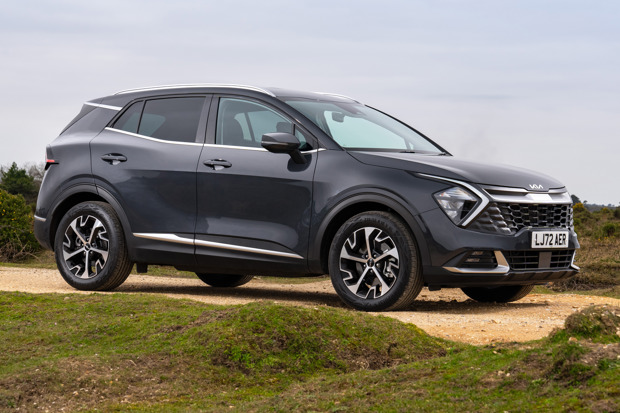Honda ZR-V long-term review

Specifications: Honda ZR-V Advance
- Run by: Phil Hall since March 2024
- Price when new: £42,895 (£43,545 including options)
- Engine: 2.0-litre hybrid
- Power: 184PS
- Torque: 315Nm
- Claimed economy: 48.7mpg
- CO2 emissions: 132g/km
- Insurance group: 35
Report 1: Honda's new family SUV joins our fleet
Sharing the same underpinnings and tech from the Civic, will the Honda ZR-V win us over like it's hatchback sibling did?

Date: 18 March 2024 | Current mileage: 7456 miles | Claimed economy: 48.7mpg | Actual economy: 44.5mpg
Last year we ran Honda's Civic hatchback for three months and loved it. We're back in another Honda, but this time it's the brand's new family SUV, the ZR-V. With the same underpinnings and lots of tech from the Civic, are we going to be just as smitten this time round?
You don't need me to tell you that the family SUV sector is hugely competitive, with the likes of the Nissan Qashqai, Kia Sportage and Skoda Karoq just some of the popular options out there. It's perhaps a little strange then that until the arrival of the ZR-V in 2023, Honda hasn't really offered a direct competitor - there's either been the smaller HR-V or larger CR-V to choose from.
Our Honda ZR-V long-termer is kitted out in top-of-the-line Advance trim (above Elegance and Sport trims) and finished in Diamond Dust Pearl (a £650 upgrade) and while there are some nice details on the pretty sleek exterior design, I can't help feeling Honda's designers could have been a bit braver with the styling. Some buyers might prefer the ZR-V in Sport trim that comes with a honeycomb-style grille, a sharper-looking front end and different bumpers. That said, it's a nicely balanced design overall and is less divisive than some rivals.
As you'd expect, our top-spec Honda ZR-V Advance is pretty comprehensively spec'd. There's some nice diamond-cut 18-inch alloy wheels, a panoramic roof, heated front and rear seats, large head-up display, 12-speaker Bose stereo, 9-inch touchscreen and a 10.2-inch digital instrument display.

There's also front and rear parking sensors (and rear camera), LED lights front and rear (with our Advance model enjoying active corner lights), wireless charging and both Apple CarPlay and Android Auto. Apple CarPlay is wireless, but just as I found when running the Civic, Android users still have to plug in their device in rather annoyingly to get the benefits of Android Auto.
What trim you pick (and what colour paint) are going to be the only big decisions you're going to have to make if you're looking to buy a ZR-V, as there's only one engine to pick from. The good news is though that it's the same hybrid engine that impressed us in the Civic. This sees a 2.0-litre petrol engine powering two electric motors, which in turn drives the wheels. You'll find at low speeds that the ZR-V will run along in EV Drive mode, but push on a bit and it'll automatically swap to Hybrid Drive, with the engine kicking in to generate the additional power required. At higher speeds the wheels are directly powered by the engine and assisted by the electric motors.
It's a clever system (and for clarity, it's not a PHEV either) and promises a combined fuel economy of 48.7mpg, but you could expect upwards of 60mpg with some careful driving. Just like the Civic is produces 184PS and 315Nm of torque, while despite the weight penalty over its hatchback sibling, is only a bit slower at 0-62mph, taking 8 seconds (compared to 7.9 seconds for the Civic).
After the Civic and the ZR-V all feels very familiar. Question is, would I be prepared to pay the extra £3000 premium for a ZR-V over a Civic? I'm not sure yet, but I'm looking forward to finding out over the next three months.
Report 2: Using the ZR-V to carry bikes
The ZR-V is fitting into family life with ease, and with a towbar fitted its now much more practical.

Date: 8 April 2024 | Current mileage: 7841 | Claimed economy: 48.7mpg | Actual economy: 43.9mpg
One of the negatives that's been levelled at the ZR-V is it's boot size. At 370 litres with the rear seats up, the amount of space available is actually less than the Civic (at 410 litres). That's before you've started to compare it to the competition - the Nissan Qashqai enjoys 504 litres, while the Skoda Karoq trumps them all at 588 litres.
Now I'm not going to say that a smaller boot is better, but for a family of four (and a dog), I don't think there's been an occasion yet when we've missed the bigger boot capacities offered on the ZR-V's rivals. Our girls are past the stage of needing buggies and the extra kit that comes with small children, so it might be a different story for those with younger families, but the ZR-V's boot is a useful shape and there's been no complaints from our dog Mary when she's travelled in the boot.
The constant rain has also meant we've come to appreciate the ZR-V's fitted boot liner. It does make it look quite functional, but it's a small price to pay to keep the carpet underneath relatively clean when we come back to the car after some pretty muddy dog walks.

Before the ZR-V arrived I was a little worried that the girls bikes wouldn't fit in the back considering the boot size, but I was relieved to find that both fitted in the back nice and easily. The larger bike needed the front wheel to pop off, but as I've found in the past, this isn't unique to the ZR-V.
That's the kids bikes sorted, but what happens if we want to ride with them? Before our ZR-V arrived I asked if it could be fitted with a towbar and Honda kindly obliged.
It's a retractable system so for the times you're not using it, it's tucked out of the way and won't spoil the lines of the car. Then when you want to fit a bike rack or pull a trailer, there's a opening mechanism positioned in the boot sill, and all you have to do is pull this upwards and out pops the towbar. There's a 13-pin harness and a maximum towing capacity of 750kg, while there's a vertical load capacity of 75kg - even if you're planning to mount two heavy e-bikes that should be more than enough. Only drawback is that the Handsfree Tailgate Access functionality on our Advance spec car is sacrificed to make way for the towbar, but it's more than a fair swap for my needs.
This meant we could easily fit a towbar-mounted bike rack, in this case a Thule Epos 2 bike carrier. Ours fits two bikes, but there is a version that accommodates three if you don't want to fill up the boot with bikes. It was a doddle to set up - it locks onto the towbar and once you've hooked up the 13-pin lead, you've got power to the lights. Only thing you need to do is disable the rear parking sensor - not to dull the noise of the beeps when you go into reverse, but to stop it automatically slamming on the brakes when it thinks you're going to smack into something.
It might sound daft, but this has been a great addition to the ZR-V - it makes it much more versatile for our needs, meaning we can have days out as a family that we wouldn't normally be able to do. So much so that we're off to The Netherlands in a couple of months with bikes in tow.
Report 3: Honda ZR-V vs Kia Sportage
How does our Honda ZR-V long-termer stack up against one of the best family SUVs going, the Kia Sportage?

Date: 26 April 2024 | Current mileage: 8253 miles | Claimed economy: 48.7mpg | Actual economy: 45.7mpg
As I've touched on earlier, the Honda ZR-V is pretty new to the market when it comes to mid-size family SUVs, so I thought it would be a good idea to see how it stacked up against one of its most popular rivals, the Kia Sportage.
Unlike the relatively streamlined ZR-V model range, there's a wide list of permutations you can have your Sportage in, with the choice of either petrol, mild-hybrid, hybrid or plug-in hybrid engines to pick from. It's the hybrid version that naturally lends itself be compared with our ZR-V's engine, but they do things a little differently. The Sportage HEV uses a 1.6-litre petrol engine and battery combination that delivers 230PS. Officially it's a bit quicker 0-62mph at 7.7 seconds, while a combined fuel economy of 51.4mpg also promises slightly better fuel efficiency.
Alongside our ZR-V long-termer and the design of the Sportage is much more striking, especially round the front of the car. Which one you prefer will come down to personal taste, but I found I had a new appreciation for the ZR-V's restrained styling. And once inside, there's an even wider step-change in design philosophy.

While the ZR-V has a much more traditional look, the Sportage's interior is dominated by two 12.3-inch displays (on '3' trims and above). One for the digital instrument display and one for the infotainment and coming from our ZR-V's rather dated looking 9-inch display, it's like going from using a Sony Ericsson phone in the mid-2000s to picking up Samsung's latest smartphone. It looks very slick and it's nice and responsive, while the clarity of the reversing camera is a noticeable improvement over the ZR-V's. However and despite all of this, I still find the ZR-V easier to use. Some of that could be familiarity, but the amount of physical buttons dotted round the dash make it more intuitive to use.
The other big difference is the boot space. We've mentioned this already, but the ZR-V has a pretty compact boot at 380 litres, but the Sportage enjoys a much larger 562-litre boot. That's quite significant and can't be ignored, especially if you've got a young family with buggies and prams to cram in the back.
Price-wise and the OTR price of the Sportage in top-of-the-range GT-Line S trim is about £2500 less than the top-spec ZR-V Advance at just over £40,000. That's a decent chunk of money, but depending on the deal you can track down, there might not be too much in it on finance. So which one should you choose? I'm leaning to the ZR-V at the moment, but it's easy to see why the Sportage has proved so popular.
